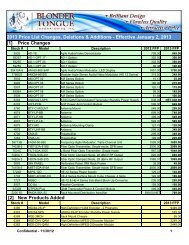Functional Block Diagram - Blonder Tongue Laboratories Inc.
Functional Block Diagram - Blonder Tongue Laboratories Inc.
Functional Block Diagram - Blonder Tongue Laboratories Inc.
Create successful ePaper yourself
Turn your PDF publications into a flip-book with our unique Google optimized e-Paper software.
Broadband Specification Guide<br />
CATV Terms & Definitions<br />
Passive<br />
Describing a device which does not contribute energy to the signal<br />
it passes.<br />
Phase Lock<br />
The control of an oscillator such that its output signal maintains a<br />
constant phase angle relative to a second, reference signal.<br />
Photodetector<br />
Any device which detects light, generally producing an electronic signal<br />
with intensity proportional to that of the incident light.<br />
Photodiode<br />
A diode designed to produce photo-current by absorbing light.<br />
Photodiodes are used for the detection of optical power and for the<br />
conversion of optical power to electrical power.<br />
Photon<br />
A quantum of electromagnetic energy.<br />
Pico-<br />
A prefix denoting one millionth of a millionth; one trillionth (10-11).<br />
Pronounced "pie-ko."<br />
Pigtail<br />
A short length of optical fiber, permanently fixed to a component, used to<br />
couple lightwave power between it and the transmission fiber.<br />
PIN Photodiode<br />
A diode with a large intrinsic region sandwiched between p-doped and<br />
n-doped semiconducting regions. Photons absorbed in this region create<br />
electron-hole pairs that are then separated by an electric field, thus<br />
generating an electric current in a load circuit.<br />
Plant<br />
A general term applied to any of the physical property of a<br />
service company, which contributes to the furnishing of power or<br />
communication services.<br />
Polarization<br />
A waveform characteristic of electromagnetic radiation. Two types of<br />
polarizations are used, linear (horizontal and vertical) and circular (right<br />
and left hand).<br />
Power<br />
Energy per unit of time.<br />
Pre-Amplifier<br />
Low noise amplifier usually mounted in close proximity to a receiving<br />
antenna. Used to compensate for down lead losses.<br />
Pulse Broadening<br />
An increase in pulse duration. Note: Pulse broadening may be specified<br />
by the impulse response, the root-mean-square pulse broadening, or the<br />
full-duration-half-maximum pulse broadening.<br />
Pulse Decay Time<br />
The time required for the instantaneous amplitude of an electrical wave<br />
to go from 90% to 10% of the peak amplitude.<br />
Pulse Length<br />
The time duration of the burst of energy emitted by a pulsed laser; also<br />
called pulse width. Usually measured at the "half-power" points (0.707<br />
times the full height of a voltage or current pulse).<br />
Pulse Rise Time<br />
The time required for the instantaneous amplitude of an electrical wave<br />
to go from 10% to 90% of the peak amplitude.<br />
Quadrature Amplitude Modulation (QAM)<br />
QAM is a modulation technique employing both phase and amplitude<br />
modulation. It is widely used to transmit digital CATV programs and cable<br />
Internet service. There are different QAM levels based upon the number<br />
of modulation states used. QAM64 utilizes 6 bits for 64 modulation<br />
states, QAM128 uses 7 bits for 128 states, QAM 256 uses 8 bits for 256<br />
states, etc.<br />
Quadrature Phase Shift Keying (QPSK)<br />
QPSK uses four phase angles to represent each 2 bits input. It is similar<br />
to QAM4 without amplitude modulation. QPSK is used in many CATV<br />
satellite transmissions.<br />
Radiant Energy<br />
Energy (joules) which is transferred via electromagnetic waves; there is<br />
no associated transfer of matter.<br />
Ray<br />
A geometric representation of a light path through an optical device:<br />
a line normal to the wave front indicating the direction of radiant<br />
energy flow.<br />
Rayleigh Scattering<br />
Scattering of a lightwave propagating in a material medium due to the<br />
atomic or molecular structure of the material and variations in the structure<br />
as a function of distance. The scattering losses vary as the reciprocal of<br />
the fourth power of the wavelength. The distances between scattering<br />
centers are small compared to the wavelength. Rayleigh scattering is<br />
the fundamental limit of fiber loss in the operating wavelength region<br />
(0.8-1.6 um) of optical fiber systems.<br />
Ratio<br />
The relative size of two quantities indicated by the quotient obtained by<br />
dividing one quantity by the other.<br />
Receiver<br />
A unit including a detector and signal-processing electronics that converts<br />
optical input into electronic output; often used in communications.<br />
91
















